A cutting-edge look at safety and security applications of photonic sensors
With its many superior qualities, photonic sensing technology is increasingly used in early-detection and early-warning systems for biological hazards, structural flaws, and security threats. Photonic Sensing provides for the first time a comprehensive review of this exciting and rapidly evolving field, focusing on the development of cutting-edge applications in diverse areas of safety and security, from biodetection to biometrics.
The book brings together contributions from leading experts in the field, fostering effective solutions for the development of specialized materials, novel optical devices, and networking algorithms and platforms. A number of specific areas of safety and security monitoring are covered, including background information, operation principles, analytical techniques, and applications. Topics include:
- Document security and structural integrity monitoring, as well as the detection of food pathogens and bacteria
- Surface plasmon sensors, micro-based cytometry, optofluidic techniques, and optical coherence tomography
- Optic fiber sensors for explosive detection and photonic liquid crystal fiber sensors for security monitoring
- Photonics-assisted frequency measurement with promising electronic warfare applications
An invaluable, multidisciplinary resource for researchers and professionals in photonic sensing, as well as safety and security monitoring, this book will help readers jump-start their own research and development in areas of physics, chemistry, biology, medicine, mechanics, electronics, and defense.
Table of Contents
Preface xi
Contributors xiii
1 Surface Plasmons for Biodetection 1
Pavel Adam, Marek Piliarik, Hana Sipova, Tomas Springer, Milan Vala, and Jiri Homola
1.1 Introduction 1
1.2 Principles of SPR Biosensors 2
1.3 Optical Platforms for SPR Sensors 12
1.4 Functionalization Methods for SPR Biosensors 26
1.5 Applications of SPR Biosensors 35
1.6 Summary 45
2 Microchip-Based Flow Cytometry in Photonic Sensing: Principles and Applications for Safety and Security Monitoring 59
Benjamin R. Watts, Zhiyi Zhang, and Chang-Qing Xu
2.1 Introduction 59
2.2 Microchip-Based Flow Cytometry 61
2.3 Microchip-Based Flow Cytometry with Integrated Optics 66
2.4 Applications 73
2.5 Conclusion 81
3 Optofluidic Techniques for the Manipulation of Micro Particles: Principles and Applications to Bioanalyses 89
Honglei Guo, Gaozhi Xiao, and Jianping Yao
3.1 Introduction 89
3.2 Optofluidic Techniques for the Manipulation of Particles 90
3.3 Enhancing Optical Manipulation with a Monolithically Integrated on-Chip Structure 104
3.4 Applications 110
3.5 Conclusion 112
4 Optical Fiber Sensors and Their Applications for Explosive Detection 119
Jianjun Ma and Wojtek J. Bock
4.1 Introduction 119
4.2 A Brief Review of Existing Fiber-Optic-Based Explosive Detectors 123
4.3 High Performance Fiber-Optic Explosive Detector Based on the AFP Thin Film 129
4.4 Generating High Quality Polymer Film - Pretreatment with Adhesion Promoter 137
4.5 Effect of Photodegradation on AFP Polymer 138
4.6 Optimizing Polymer Concentration for Optimized AFP-Film Thickness 138
4.7 Explosive Vapor Preconcentration and Delivery 139
4.8 Future Directions and Conclusions 143
5 Photonic Liquid Crystal Fiber Sensors for Safety and Security Monitoring 147
Tomasz Wolinski
5.1 Introduction 147
5.2 Materials and Experimental Setups 149
5.3 Principle of Operation 153
5.4 Tuning Possibility 157
5.5 Photonic Devices 172
5.6 Photonic Liquid Crystal Fiber Sensors for Sensing and Security 176
5.7 Conclusion 178
6 Miniaturized Fiber Bragg Grating Sensor Systems for Potential Air Vehicle Structural Health Monitoring Applications 183
Honglei Guo, Gaozhi Xiao, Nezih Mrad, and Jianping Yao
6.1 Introduction 183
6.2 Spectrum Fixed AWG-Based FBG Sensor System 186
6.3 Spectrum Tuning AWG-/EDG-Based FBG Sensor Systems 190
6.4 Dual Function EDG-Based Interrogation Unit 215
6.5 Conclusion 219
7 Optical Coherence Tomography for Document Security and Biometrics 225
Shoude Chang, Youxin Mao, and Costel Flueraru
7.1 Introduction 225
7.2 Principle of OCT 229
7.3 OCT Systems: Hardware and Software 233
7.4 Sensing Through Volume: Applications 242
7.5 Summary and Conclusion 251
8 Photonics-Assisted Instantaneous Frequency Measurement 259
Shilong Pan and Jianping Yao
8.1 Introduction 259
8.2 Frequency Measurement Using an Optical Channelizer 261
8.3 Frequency Measurement Based on Power Monitoring 266
8.4 Other Methods for Frequency Measurement 287
8.5 Challenges and Future Prospects 291
8.6 Conclusion 292
References 292
Index 297






